The most amazing facts about rivers in the world. Unusual rivers of the world and the rivers of Russia - Rivers with sour water. The unique river of the world - the River, which is only at night
The usual element of each landscape is considered to be the river. There are a lot of them today. A lot of secrets in itself conceals both Ob, and Oka, and Volga river. Interesting facts about these and other rivers of the world are not familiar to everyone. Not all the facts about rivers tell on geography at school. They are much more.
1. Interesting facts about the rivers confirm that the Nile is considered to be the longest river. Its length is approximately 6853 km.
2. Water is most found in the Amazon River.
3. The cleanest river is the Boncha. Located in the Republic of Mari El.
4. The most mysterious river is in Colombia and is called Caño Crystals. It consists of 5 colors.
5. Kongo is the deepest river in the world.
6. The most polluted river in the world - Tsitarum (Citarum) is located near the city of Jakra, the capital of Indonesia. Australia also has the most polluted river and its name is the Royal River. It receives pollution mainly from the chemical industry.
7. In Poland, the Velna and Nelba rivers cross at a 90 degree angle.
8. Finland is considered the most water country. About 650 rivers flow through its territory.
9. There is a country in whose territory there is not a single river. This is Saudi Arabia.
10. A popular fictional river is the Styx. This is the river that flows in the underworld of Hades.
11. The nature of the puzzle are the blue rivers. They flow through the territory of Greenland and look like small streams.
12. On planet Earth there are 6 rivers with the same name Don.
13. The most ridiculous river is the Elk river, and there is also the Lysaya Balda (a river in the village of Zaryannoe, Ukraine) Bolotnaya Rogavka (a village in the Novgorod region)
14. Once a year the Mekong River spews fireballs glowing from its depths.
15. The Nile is considered the most ancient river.
16. The waves on the Amazon River can reach a height of 4 meters.
17. Each spring, the river Kosi, located on the territory of India, is making a new course for itself.
18. Most of the rivers flows into the Atlantic Ocean.
19. One of the banks of the Ural River is in Asia, and the second is in Europe.
20. The Volga River has a powerful hydroelectric resource.
21. The most widespread river on Earth is La Plata.
22.It happened when the river was sentenced to death. When King Cyrus, having redirected across the river, lost the life of his horse, he ordered the river to be removed.
23. The Lena River is distinguished by powerful ice jams and ice conditions.
24. Sometime diamonds were found at the bottom of the rivers.
25. In the Willy Wonka film, there was a chocolate river made from water and chocolate. Soon after, she had a rather unpleasant smell.
26.In 2010, the first bridge across the Amazon River was opened.
27. More than 26 thousand tombstones located in the Delaware River.
28.Photograph with the image of the River Rhine is considered the most expensive in the world. Over 4 million, it was sold at auction.
29. The “ghostly” river flows under Manhattan.
30.About 20 hidden rivers flow under the London Bridge.
31. The Ural River is considered to be the natural water boundary between Asia and Europe.
32.It is near the Amazon is the largest rainforest in the world.
33. The Congo is considered to be the deepest river in Africa and the only river crossing the equator twice.
34.The first river police in the world was created on the River Thames, which flows in London.
35.With the swamp originates the Moscow River.
36. The Amur River is also unusual. Facts confirm that this river has two sources: Zeya and Bureya, and its discoverer was Vasily Poyarkov.
37. The river in South Korea has the nickname "River of the Dead." Many corpses are caught from it.
38.The sacred river of India and its spiritual center is the river Ganges.
39. The Oka River is considered the largest tributary of the Volga.
40.Around 12 reservoirs were built in the Lena River basin.
41. Of the 70 rivers of Asia and Europe, 50 rivers flow through the territory of the former Soviet Union.
42.The name of India originated precisely from the name of the Indus River, because the valleys where this river flows, became the dwellings of the first settlers of the state.
43. There is not a single bridge across the Amazon River.
44. Piana is considered to be the most winding river in the world.
45. The king of all the rivers is the Amazon.
46. The Dnieper River, located on the territory of Ukraine, was part of the legendary path "From the Varangians to the Greeks."
48. The beginning of the famous path “From the Varangians to the Greeks” was the Volkhov River, on which overseas merchants traveled.
49. The Yellow River is also called the Yellow River, because it is the most turbid of all existing sources of the world.
51. The El Rio Vinegre River, located on the territory of the Puras Volcano in Colombia, is considered the most acidic.
52.Through Argentina and Chile flows a river with turquoise water, and it is called Futaleufu.
53. Every year about 2 million people visit the Zambezi River. She attracts the eye with her cascades.
54. Danube covers 10 European countries. This is the main waterway of Central Europe.
55. The most winding river of Africa is the Gambia.
56. Approximately 20 times a year, the Shuya River, located on the territory of Karelia, changes its direction.
58. Mississippi in translation means "Big River".
59. The Tista River is considered a lifeline.
60.In the 9th and 11th centuries, the Nile River was twice covered with ice.
61. The shortest river in the world is Reprua. It flows from an underground cave near the Black Sea and immediately flows into it.
62. In the Voronezh region there are 2 rivers, called Maiden.
63. The Amazon River runoff is larger than that of the 10 following largest rivers.
64. More than 500 tributaries has the Amazon River.
65. "Rio" from Portuguese and Spanish is translated as "river". That is why many Latin American cities on the rivers begin with the word Rio.
66.In Chile, there is a night river. During the day, the river bed dries out to such an extent that it is impossible to wet your feet.
67.At the bottom of the river flows in Australia with the name Gascoigne.
68. The river Kapuas flows, creating a branched delta.
69.The Cooku River has the funniest name.
70. The River Yellow River 1500 times caused trouble.
71. While pulling fish from the River Puarenga on the North Island, it can be cooked immediately. The river is fed from cold and hot springs, and the water in it does not have time to mix.
72. No fish lives in the Acid River, located in Colombia. It contains about 11 grams of sulfuric acid.
73. Ancient Egyptians always worshiped the Nile River and devised hymns in its honor.
74. The queen of all the rivers is the Amazon. It is in it that the largest river dolphin lives.
75.The Amazon in 2011 was recognized as one of the wonders of the world.
76.Neil is the cradle of human civilization.
77. The Pyramids of Giza, the temples of Karnak and Luxor and the Valley of the Kings are located on the banks of the Nile.
78. In Russia, 2.5 million rivers flow.
79. The water of the Ob River in summer and autumn has a striped structure.
80. Hudson is a deep river, and its depth can reach 65 meters.
81. The most scenic waterway in Europe is the River Rhine. It was she who formed the history of Europe stronger than other sources.
82. Through the heart of the old kingdoms such as Bohemia, Saxony and Bavaria, only the Spree River passes.
83. The Brahmaputra River flows the fastest.
84.Each second, the Amazon discharges 200,000 m3 of water into the Atlantic Ocean.
85. The River Severn is considered the longest in the UK.
86.The Congo River has another name Zaire.
87.There are no living creatures in the river Jumna.
88. The river Kanyo Crystals is also called the “rainbow” river, and it is the most beautiful of all existing in the world.
89.A pseudonym of Lenin descended from the Lena River.
90. The symbol of Russia is the river Volga.
91. The Hudson River is the political and geographical border of two states of America: New Jersey and New York.
92.On the Missouri River, another river flows - the natural “heart”, which is shaped like a heart.
93.Only near the Mekong River, you can still meet the river markets.
94. The name of the River Rhine from Celtic is translated as “flow”.
95.Every second, the Congo River transports 500 cubic meters of water.
96. The Dnieper is considered the most famous and large river in Ukraine.
97.In Australia, there is only one river constantly flowing called Marrambiji.
98.About 280 lightning bolts per hour within 10 hours, it hits the mouth of the Katatumbo River.
99.The length of the smallest river is only 18 meters.
100. For a river to exist, it needs food.
The Nile is one of the longest rivers in the world; in fact, it was once the longest, but, according to recent studies, it is now longer in length than the Amazon River. The length of the Nile River is approximately 6,695 km, and the river has two tributaries. Only 22% rivers flows through Egypt, the rest falls on other countries - Sudan, Burundi, Ethiopia, Zaire, Kenya, Uganda, Rwanda and Tanzania.
The Amazon River in South America is the second longest river in the world after the Nile. It is 4,080 miles long and flows from the Andes Mountains in Peru through Brazil into the Atlantic Ocean. The Amazon contains more water than any other river in the world.
The number and size of rivers flowing into the Atlantic Ocean are much larger than the number and size of rivers flowing into the greatest of all oceans - the Pacific Ocean. This is explained by the fact that high mountains stretch along the shores of the Pacific Ocean for a long distance. As a result, the Pacific Ocean absorbs water from only 20 percent of the land area, while the Atlantic and Arctic Oceans collect water from 53 percent of the total land mass of the globe.
The Nile River was covered with ice twice - in the 9th and 11th centuries.
Irtysh is one of the cleanest rivers in the world. The Irtysh, a river with a length of 4248 kilometers, is considered the main tributary of the Ob. Irtysh flows through the territory of several countries: China, Kazakhstan and Russia. In the latter, the Irtysh River is considered the longest (2010 kilometers) field of the Lena River. Its speed here does not exceed 0.5-1.5 meters per second.
The Lena River flows through the territory of Eastern Siberia, and is one of the largest and most abundant rivers in the world. This is evidenced by its name Ulakhan-Yuryakh, which in translation from Yakut means “Big River”. By length in Russia, the Lena River ranks third in the world in the tenth.
Sarno - a stream that passes through Pompeii to the south of the city of Naples. The river is considered the most polluted river in Europe. Polluted pool water flowing into the Gulf of Naples increases pollution of seawater.
The widest river in the world is La Plata (Rio de la Plata), it is also called the Silver River. Its width (from the confluence of the rivers Uruguay and Paraná) ranges from 48 to 220 km! But because of such a width, the depth of the river is small and navigation along it is difficult.
The Far Eastern Kontrovod river changes its course once every three months, flowing into the Ussuri River (Amur tributary), then into the Bikin River (Ussuri tributary).
Near the mouth of the Yenisei is now the famous port of Igarka. It originated in the years at the place of the fishing camp in which the hunter-fisher Yegorka lived. Nenets and called him Igorka.
River streams annually carry into the seas and oceans 16 billion tons of solid materials in the form of stones, various debris or solutes. If all this is loaded into freight cars, then a train will form, which will girdle the earth equator 30 times.
In Poland there is a place where two rivers meet at right angles - Welna and Nelba. At the same time, due to differences in water temperature, different speeds and levels of flow of water, rivers do not mix. Experiments confirmed this: shortly before the crossing point, paints of different colors were poured into the rivers, and no mixing occurred.
On the territory of the Lena River basin, 12 reservoirs have been built; the total volume of water in them is equal to 36,200.7 million cubic meters.
Not a single river in the world stands next to the Amazon. The area of its basin exceeds 7 thousand km ². This is twice the area of the Congo River, which is in second place.
The Royal River is the most polluted river in Australia. The river is polluted by chemical waste from the mining industry. About 1.5 million tons of sulphides have been released into the river annually since 1995.
The deepest river in the world is of course the Congo! It is also the second river in the world in terms of water flow, after the Amazon. In narrow areas of 300 meters wide, the Congo can reach a depth of 230 meters or more. What certainly makes it the deepest river in the world.
The Gind River, which is now called Diyala, flowed through the territory of modern Iraq. In one of the campaigns to Babylon, the Persian army led by Tsar Cyrus II, the sacred white horse drowned in it. Cyrus ordered the execution of the river, pulling out many channels.
Of the 70 rivers of Europe and Asia with a length of more than 1000 kilometers, 50 flows through the territory of the former Soviet Union.
Siberian rivers bring as much heat to the Arctic Ocean as burning 3 billion tons of fuel would give. If it were not for the rivers, the climate of the North would be more severe.
Finland is a unique water region: 188,000 lakes and 650 rivers cover 10% of the total area of the country.
The dirtiest river in the world is in Indonesia. Citarum - a river in Indonesia, flows near the capital of the country Jakarta. And it collects waste of 9 million city. Local residents have already forgotten that there once was a fish. Collecting litter in the river and handing over for processing is now much more profitable than fishing.
The Reprua River is the shortest river in the world. According to various sources from 18 to 40 meters. It flows out of underground caves near the Black Sea, into which it immediately flows. The water in the caves appears due to the melting of snow and ice in the mountains. Here is a mini river.
In the Voronezh region flow two rivers named Maiden, both flow into the Don, and both have a tributary of the river named Rossoshka.
Each year, the Kosi River (in India) is making a new course for itself, emptying large areas of its movement. Crops, villages, cattle - she sweeps everything in its path. The river is also famous for its “carrying capacity”: the total annual volume of sediment is a huge number - 116 million cubic meters. Pebbles, sand, clay, which the river annually brings to the valley from the mountains of the Himalayas, you can fill 8 million freight cars!
The name of the country "India" comes from the name of the Indus River, as the valleys located near it became home to the first settlers.
The most unusual river in the world. And perhaps the most beautiful! Caño Cristales, the River of Five Colors, the Crystal River. There is practically no fish in this river. It’s all about the algae that grow in the river. They are green, purple, blue, yellow and black. It depends on the time of year. The water in the river is almost distilled, there are practically no minerals and salts, it is unsuitable for drinking. But in the Crystal River there are still small fish that somehow find food for themselves. Caño Cristales feeds on rain and mountain water.
There is not a single bridge across the Amazon River, a river almost 7,000 kilometers long. Only in 2010, a bridge was built over one of its tributaries, the Rio Negro. This bridge connects the largest port of Manaus in Amazon with the city of Iranduba, and its length is 3,595 meters.
Naryn is almost as good as the water reserves of the Volga. The power of the Volga (its hydropower resources) is 6.20 million kilowatts, and the power of Naryn is 5.94 million kilowatts.
In Moscow there is the river Elk, and the largest of the streams flowing into it is called Losenok.
The Indigirka River flows into the Arctic Ocean and is considered the coldest river in the world. Toward the end of winter, the lower course of Indigirka may freeze through
In Saudi Arabia there is not a single constantly flowing river.
One bank of the Ural River is located in Europe, the other - in Asia.
The length of the Neva River is only 74 km, but, despite this, it flows through the territory a little less than the territory of Italy. The Neva delta includes the Ladoga, Onega, Saimaa, Ilmen lakes, as well as the Svir, Volkhov and Vuoksa rivers. In the world there is only one similar water system - the Great Lakes in North America. The main river of St. Petersburg Neva carries more water than the Don and the Dnieper combined.
The geography textbook (Nature of Russia) states that Piana is the world's most tortuous river. It flows almost completely through the Nizhny Novgorod region, but it also enters the Mordovian lands, albeit very slightly. The length of the river is more than 400 km, and the distance from the headwaters to the lower reaches is only 30 km.
To learn the power of the elements of Water, we have collected the most interesting and incredible facts about the rivers.
1. Fewer rivers flow into the Pacific Ocean (the largest ocean of our planet) than the Atlantic. This is due to the mountain range, which stretches along the Pacific Ocean, therefore it accounts for 20% of the Earth’s land, while the Arctic and Atlantic oceans - 53%
2. River flows to the oceans and seas annually carry approximately 16 billion tons of stones and debris. If this amount is loaded into the train, then you will get a train machine, which is equal to 30 circles of the Earth's ball.
3. 70 rivers flow through the territory of Eurasia. Their length is about 1 thousand kilometers, and 50 of these rivers flow through the territory of the post-Soviet countries.
4. One of the most amazing rivers, which has one bank in Europe and the other in Asia, is the Ural River.
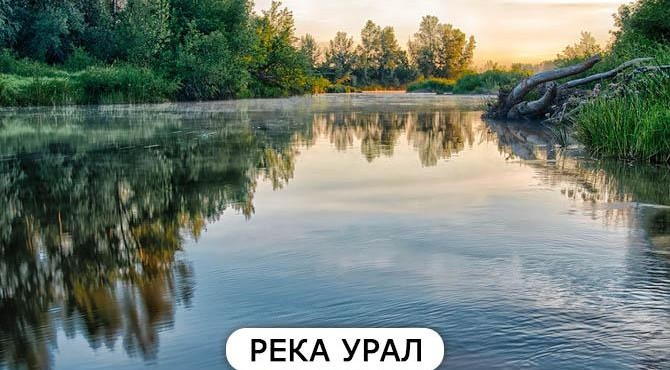
5. Due to the huge amount of heat carried by the Siberian rivers, the climate of the North is not as severe as it would have been if there were no rivers.
6. The Kosi River, India, is building a new course for its waters each year, emptying fields and villages on its way.

The nature of Russia is very majestic and rich, but Russian rivers always attract particular attention. Folk songs were composed about them, whole cities were named after them. In short, each river has its own history. And therefore you can always bring interesting facts about the rivers of Russia, which relate to these large-scale watercourses, like veins penetrating the entire territory of our country.
The name of the river means "grandmother." It is not surprising that the name is so respectful - after all, it is one of the largest rivers in the world. In Russia, it is the largest by total basin area. However, there are other versions of the origin of the name. In the Komi language, it also means “snow” (after all, it originates near the snow), but in Iranian it can be interpreted as “water”, which does not require explanation at all.
Volga
We now know this river as the Volga, and our ancestors knew it under a huge number of other names, including: Ra, Arak, Itil, Ethemiya, Erdil and so on. It is also the largest river in Europe - and one of the largest, in fact, in the whole world. In total, it flows through as many as 15 constituent entities of the Russian Federation, which makes it truly indispensable. She also became an object of folk legends. It is believed that a mysterious mystical folk is found near it - divya people.
Lena
Maybe Lena is not technically considered to be the largest river in the country, but it is the largest river whose basin entirely lies within the territory of Russia. By the way, its name, in fact, is a distorted Ely-Ene, that is, a “big river”.
Yenisei
The place where the Small and Big Yenisei merge is considered to be the geographical center of all Asia. More than 500 rivers flow into the Yenisei, if you add up the length of which, something like 300,000 kilometers will come out. Interestingly, technically, the Yenisei can be considered shorter - the segment below the merger with the Angara can be attributed to the Angara, by all indications it is, but it is already settled - it is precisely what the Yenisei is considered to be dominant in that segment.
Neva
This river is very small, only 74 kilometers long, but at the same time its territory is close in size to the territory of all Italy. And because of the presence of many lakes and rivers that are included in its delta, the river carries a total more water than the Dnieper and Don together. In general, this entire water system is so unique that there is only one approximate analogue of such a water system in the world, comparable in scope - these are the Great Lakes of America.
Drunk
Drunk does not apply to those rivers that are heard, but it still has a curious feature that allows it to stand out from many other watercourses. The fact is that this is the most winding river in the whole world. So you can joke about her "drunk" name, because it fully justifies her "wagging".
Irtysh
What characterizes the Irtysh is its exceptional purity. After all, this is one of the cleanest rivers in the world. But in Russia it is one of the slowest large rivers. Usually its flow rate on average is very, very small meter per second. So the main flow of the Ob flows though slowly but surely.
Ural
This river is unique in that one of its banks is in Europe and the other is in Asia. Albeit not all along its length, it divides two parts of the world. She also has a bit more negative fame - this is where the famous Chapaev drowned. The same place was romanticized by the famous writer Victor Pelevin - in his work the name is deciphered as “The conditional river of absolute love”, although in the original it only comes from the mountains of the same name.
Small and Big Vishera
In the Novgorod region there are two localities - Big and Small Vishera. And there is an interesting paradox - Big less than Minor at times. It would seem, where does the river? Everything is simple - these settlements are named after the rivers on which they stand, but for the latter, the size ratio is logical.
Of course, it is impossible to cover all the abundance of rivers and the interesting facts connected with them, which is typical for Russia. After all, there are about 2.5 million rivers throughout the country, and behind each of them there is certainly an interesting story, an amusing fact or an interesting set of statistical data. But even these few examples characterize all the natural wealth and diversity that is inherent in the territory of Russia.
The rivers are called natural large water flows that flow in the river valley (in places where the relief is lowered), along the washed channel (depression in the valley), towards larger rivers (towards the mouth). Given that these streams are replenished by groundwater and precipitation, they are directly involved in nature, during which water is constantly redistributed over land and in the atmosphere.
The rivers originate from barely noticeable small springs, groundwater, in lakes or swamps, located glaciers. It is worth noting that the combination of a river and a lake, especially if the reservoir is large, often gives life to the largest river flows, for example, the beginning of the Neva River is located in Lake Ladoga.
The source of the river is formed from a small stream, to which other small streams join, forming first a stream, then - river streams. Some of them after some time turn into large rivers (the main river flow moves towards the sea or ocean), while others turn out to be their tributaries.
The more rain falls in the area where the main river flows (this is typical of the equatorial belt), the more tributaries move towards it, forming a river system (the area from which this system collects water is called a pool). But in the desert regions, where precipitation is extremely small, the river, no matter how large it is, has almost no tributaries. A striking example of this is the longest river in the world, the Nile, which flows in Africa - it feeds mainly on the account of the rains falling at the equator.
Therefore, that part of the earth's surface, from which water is collected first in streams, then in streams and small rivers, scientists call the catchment area.
Thus, the catchment area of the trickle is very small and amounts to several square meters, whereas at the stream the drainage basin expands to several hectares, and near the river reaches square kilometers. The line that separates the watersheds is called a watershed, from where water flows in two opposite directions.
Since the water arteries are very unevenly distributed on the surface of the planet, the answer to the question of where the river flows most of all may surprise: the Atlantic Ocean has a greater flow than the Pacific Ocean. This is due to the fact that almost along the entire coast of the largest ocean of our planet, from the American continent, mountains stretch, stopping large rivers and directing them to the other side (only 20% of all the Earth’s rivers reach it, while in the North and Atlantic oceans flow over 53% of river flows).
Nutrition
If the water flows would not be replenished along the way by the water flowing into them, the river would not have reached the mouth. Therefore, in winter, the rivers are fed through the release of underground waters into the river bed, while the river is replenished in spring due to melting snow or glacier, and in the summer, rain takes an active part in this process.
It is interesting that there are river flows, which are characterized only by rainwater supply (the largest river in the world is Amazon) or glacial (Amu Darya in Central Asia), and there are those who take water from where they can: they are characterized by mixed food (almost all Russian rivers ).



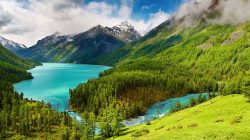

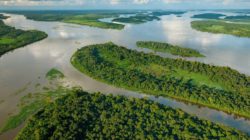
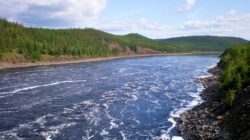
Water in the water arteries of our planet comes from only 60% of the land: in dry regions the amount of precipitation is small and almost immediately irrevocably absorbed into the ground, whereas in cold areas the moisture freezes - and in order to get to the river, frozen water can escape a lot of time.
Classification
The water arteries of our planet are usually divided into flat, mountainous, sometimes mentioned underground, marsh, lake and karst.
Mountain rivers flow in narrow valleys over a terrain that is characterized by a large angle of inclination, due to which the speed of the river, originating in the mountains, is high. Their sources are high in the mountains, and the channel often occupies the entire bottom of the river valley. True, on the plain they are strongly modified (first of all, the speed of the flow decreases) and they acquire all the signs of the lowland rivers.

But the flow rate of a lowland river is low: the source of the river is located at a small height, while the territory along which they flow, moving towards the mouth, has a small slope. For flat streams is characterized by a wide river valley, in the center of which they have paved their way, sloping low slopes, meandering channel (a vivid example: the longest river in the world the Nile or the most affluent river Amazonka).
It is worth noting that both mountain and flat river flows may have rapids, the presence of which dramatically changes the speed of the river flow.
They are formed due to the fact that the bottom of river valleys usually consists of loose rocks that are very easily washed away by the flow. But there are parts of the river where the bottom of the valley consists of hard rocks (for example, granite or shale), which slowly erodes and forms ledges in the middle of the river. Passing them, the water speed increases, it foams, splashes take off, whirlpools are formed, and if the height of the ledge exceeds a meter, waterfalls appear.
Also interesting features have underground rivers that flow underground in caves. They usually occur in the rocks formed from limestone deposits. The longest river Puerto Princesa, flowing in karst caves, is located in the Philippines, on the island of Palawan, and its length is about eight kilometers.
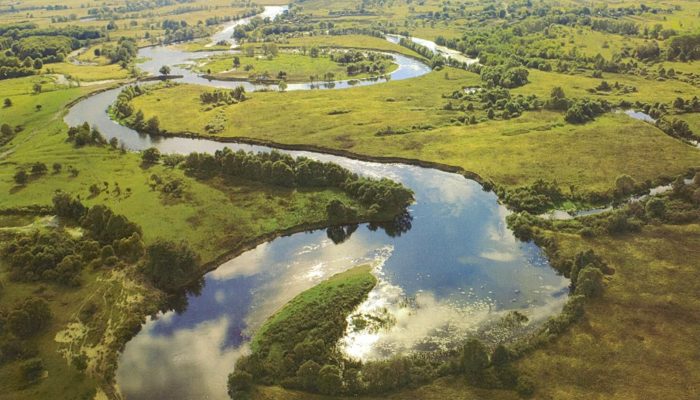
As for the size of the territory covered by waterways, the classification is as follows:
- Small - usually it is plain water flows, the catchment area of which is from 1 to 2 thousand km2, and the length of rivers - from 10 to 100-200 km;
- The averages are mainly streams flowing on a plain, the catchment area ranges from 2 to 50 thousand km2, and the length of rivers ranges from 100 to 500 km;
- Large - large river flows, whose length exceeds 500 km, usually cross several geographic latitudes at once. These include flat river systems, the catchment area of which exceeds 50 thousand km2, and mountain rivers with a catchment area of 30 thousand km2.
The role of the water arteries in the life of the planet
Rivers and lakes in the life of our planet play an important role: they not only actively participate in the water cycle in nature, but also have a significant influence on the formation of the relief. For example, they erode rocks and carry them along the coast towards the mouth. According to scientists, the rivers flow annually transfers to the mouth about 16 billion tons of stones, rocky debris and other materials.
The greater the slope of the area where the stream flows, the more destructive its influence on the rocks (this is noticeable when the river in spring during or in summer due to heavy rains overflows and floods the entire valley, and sometimes leaves its borders). At the beginning of its path, all the rivers of the world actively crash into the ground, forming and deepening the valley.
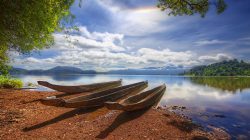
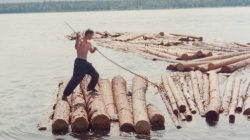

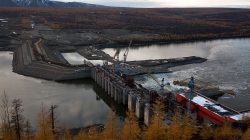

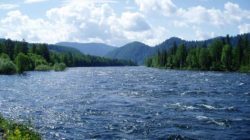

In the middle part of the river and closer to the mouth, where the angle of inclination of the terrain through which the stream flows decreases, water begins to delay the rocks brought by it, erodes the slopes of the valley and, reducing their base, makes it steeper, and on the bank of the river, if the bank sediment, forms beaches.
Man and river flows
Man has long learned to use the current water arteries of the Earth in his own interests: almost all the settlements of ancient civilizations were located on the banks of the river - water in former times was a source of food, contributed to the development of agriculture.
Particularly good was the soil at the mouth of the river: due to frequent spills, the land was well irrigated, which contributed to fertility (in our time there is also a high population density).
All settlements along the river, throughout the history of the development of human civilization, had an excellent opportunity to develop trade, transporting goods over great distances, contributing to the prosperity of the city and improving their well-being. At the same time, representatives of different countries often drew along the river along the river.
With the development of new technologies, people have learned to use the energy of water streams. The simplest example is a windmill located on the bank of the river, or a hydroelectric power station built along the river, which allows not only to get cheap electricity, but also the dam built at the same time allows you to control the amount of water flow, and also creates water reservoirs where water accumulates, and then consumed as needed.
New Articles
- What is the highest peak of the Ural Mountains
- The most ancient religions in the world
- What continents are washed by the Atlantic Ocean?
- Can I wear jewelry of the deceased?
- Snake, Bowl and Staff: The Origin of Medical Symbols
- Interesting facts about hares
- Names of famous brands in other countries
- Karelo Finnish epic kalevala protagonists
- 17 18 weeks pregnant sensations
- Why do people become so aggressive
Popular articles
- Expression twice in one river, meaning and meaning
- Gusli - musical instruments
- Report: Temperature Scales and Thermometers
- Which side to sew on chevron
- How to draw emblems for school
- Unusual rivers of the world and the rivers of Russia - Rivers with sour water
- Numb of the little finger on the right hand: causes and methods of treatment
- Why development is important for a person
- Constellations from ancient atlases
- What happens at 31 weeks
